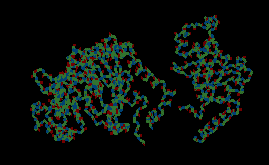
AP4A Research

Alison Hindley (e-mail : a.hindley@ic.ac.uk)
3rd year PhD student - Protein Engineering of Stress Protein LysU
Manuela Mussino (e-mail : mmussi@ic.ac.uk )
1st year student - Ap4A analogue synthesis; Chemistry of Stress Protein LysU and LysU mutants
Ap4A and related dinucleoside polyphosphates are molecules which are ubiquitous in living organisms,
but whose exact role in cell growth and survival is not fully understood. Implications are that they have
roles in stress response, cell proliferation (as internal signal nucleotides), platelet aggregation, and may
act as external signal molecules in the blood.
Ap4A is synthesised in cells by amino acyl tRNA synthetase (aaRS) enzymes - in the presence
of zinc ions. Of those aaRS enzymes known to synthesise Ap4A, the most efficient to date is the stress
induced lysyl tRNA synthetase from Escherichia coli, known as LysU. In E. coli, there are two lysyl
tRNA synthetases, the constitutively expressed protein LysS and the stress-induced protein LysU.
Owing to the properties of LysU both as a stress protein and as an efficient Ap4A synthase, we have
been intensively studying the structure and chemistry of this protein. Previously in the group, the basic
enzymology of LysU was studied and the mechanism of LysU-catalysed Ap4A synthesis determined. The
X-ray crystal structure was solved in collaboration with Dr Sylvia Onesti (Imperial College). In addition, LysU was shown to be a very effective catalyst for the
formation of Ap4A analogues of the approximate general form Ap4N (where N is an unspecified
nucleoside). Analogues containing hydrolysis resistant phosphodiester linkages were also synthesised
successfully.
In order to increase the number of analogues that can be synthesied using this enzyme, we have
performed protein engineering experiments on LysU to modify the enzyme active site so as to learn
more about the Ap4A synthase mechanism and alter the specificity of the enzyme to make a wider
range of Ap4A analogues, even Gp4G analogues. In the future, we will use our Ap4A analogues to try to understand the
function of these fascinating small molecules.